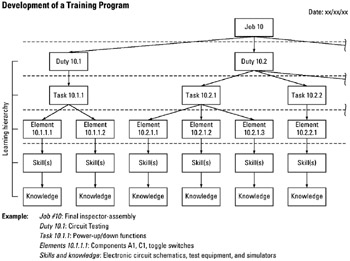Tools - T - Y
Tool 196: Task Analysis
| AKA | Job Analysis |
| Classification | Analyzing/Trending (AT) |
Tool description
A task analysis is a systematic process used to break down a job into smaller and smaller activities and to identify the skills and knowledge requirements needed to perform the job. This process can also be useful to identify training requirements, tools and equipment, work instructions, and procedure manuals. Task analysis documents provide input data needed to develop training programs and job descriptions.
Typical application
-
To breakdown a job and analyze identified tasks for the purpose of determining skill and knowledge requirements.
-
To identify the specific attributes of a complex job.
-
To compare the actual performance of a job to the desired performance level.
Problem-solving phase
| Select and define problem or opportunity | |
| Identify and analyze causes or potential change | |
| → | Develop and plan possible solutions or change |
| → | Implement and evaluate solution or change |
| Measure and report solution or change results | |
| Recognize and reward team efforts |
Typically used by
| 1 | Research/statistics |
| Creativity/innovation | |
| Engineering | |
| 2 | Project management |
| Manufacturing | |
| Marketing/sales | |
| 3 | Administration/documentation |
| Servicing/support | |
| 4 | Customer/quality metrics |
| Change management |
before
-
Needs Analysis
-
Activity analysis
-
Cluster Analysis
-
Symbolic Flowchart
-
Work Flow Analysis (WFA)
after
-
Milestones Chart
-
Action Plan
-
Activity Cost Matrix
-
Project Planning Log
-
Resource Requirements Matrix
Notes and key points
-
A task analysis breaks down any job into duties, tasks, elements of the task, and skill and knowledge requirements to perform the tasks, and it could also indicate task sequence and frequency. On the basis of this data, a training program, work instructions, or a job description can be developed.
-
Numbering schema for job-duty-task-element identification:

Step-by-step procedure
-
STEP 1 First the job analyst reviews the objective and the process of the task analysis. See example Development of a Training Program.
-
STEP 2 Next, all duties of the job are identified and recorded on a whiteboard as shown in the example.
-
STEP 3 Duties are broken down into tasks. At this level, task frequency and sequence are noted.
-
STEP 4 This process continues until elements of each task have been identified and recorded on the whiteboard. Again, the sequence of element completion is recorded.
-
STEP 5 Next, the skills and knowledge required to successfully complete each element are listed. This information is added underneath each element in the task analysis flow diagram.
-
STEP 6 Lastly, team participants check every duty, task, and task element for special performance conditions or criteria.
-
STEP 7 The task analysis diagram receives a final check by participants; it is then dated and copied for future reference.
Example of tool application

EAN: 2147483647
Pages: 326